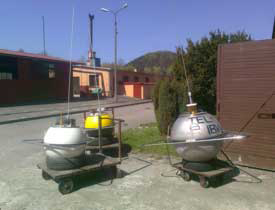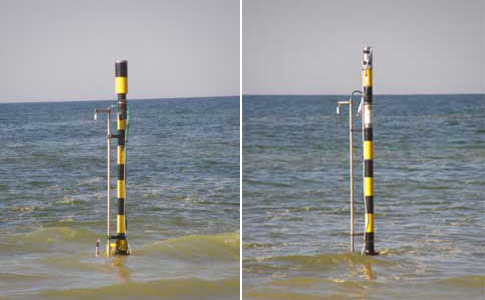Recently, a new survey has been commenced at the IBW PAN Coastal Research Station (CRS) in Lubiatowo (south Baltic Sea, Poland). Two additional wave buoys (one possessed by IBW PAN and one obtained from the Institute of River and Coastal Engineering of the Hamburg University of Technology for conducting joint research) have been deployed in the coastal waters so that there are now in total three Directional Waverider buoys (produced by Datawell BV, the Netherlands), moored in the close vicinity of each other. The set of devices, consisting of two buoys DWR-7 Mk. III and one buoy DWR-9 Mk. II (see Fig. 1), is located at the depth of 18 m, about 1.5 nm from the shoreline. The buoys are moored at distances of ca. 150 m from each other, on the direction WNW-ESE.
The investigations, carried out within a research project entitled “The study on formation mechanisms of extreme waves and wave events”, funded by the National Science Centre (NCN, Poland), are aimed at synchronized recording of waves, in order to understand the origin and physics of extreme waves. The multi-point measurement system recording waves approaching from different directions allows the separation of the progressive waves from the temporary effects of waves’ concentration.

Knowledge of generation and formation mechanisms of extreme waves and extreme wave events is particularly significant. The main problem in the existing knowledge and current recognition of extreme waves is the fact that the available field wave data come from single-point measuring systems, which cannot allow the separation of the extreme progressive waves from the momentary effects of concentration of waves with different phase velocities. It is still unknown whether the “freak waves” are progressive waves, where for example dispersion is balanced by the specific shape of the wave and nonlinear effects, or these are mostly temporary effects of concentration of waves with different velocities. This information is essential for the theoretical model of this phenomenon.
In addition, four nearshore string wave gauges and an electromagnetic current meter (see the exemplary measuring stations in Fig. 2) have just been installed at CRS Lubiatowo. This survey, carried out within the other Polish national (also NCN-funded) project, is focused on the identification of infragravity waves (such as e.g. edge waves), being the specific wave motion close to the shoreline, in shallow-water regions. These waves have periods of a few minutes and accompany the typical shallow-water gravity waves (with periods of several seconds). It is of particular interest to find out what the parameters of the infragravity waves are and in which conditions (defined by the offshore wave parameters) these waves occur. Results of these field investigations will be helpful in testing and further development of theoretical models describing generation and features of the infragravity waves.

